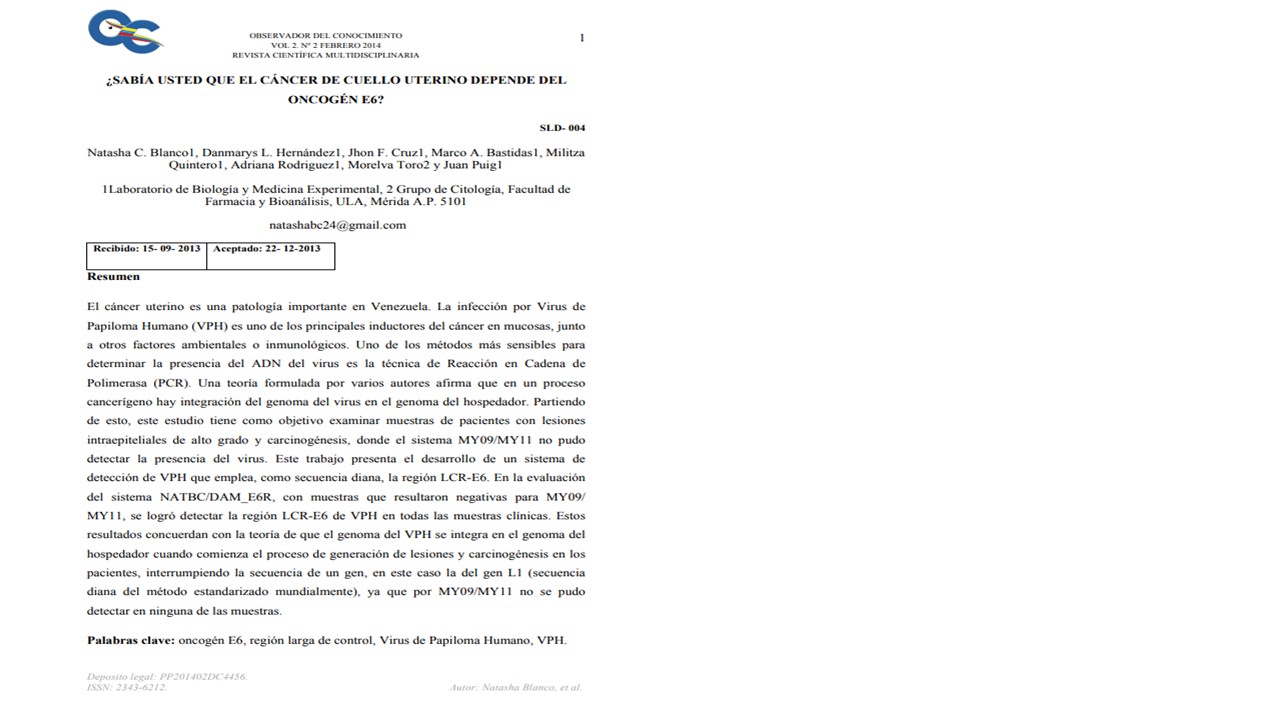Did You Know That Neck Cancer Uterine Depends On Oncogén e6?
Keywords:
E6 oncogene, long control region, Papilloma Virus Human, HPVAbstract
Uterine cancer is an important pathology in Venezuela. Infection with Human Papilloma Virus (HPV) is one of the main causes of mucosal cancer, along with other environmental or immunological factors. One of the most sensitive methods to determine the presence of the virus's DNA is the Polymerase Chain Reaction (PCR) technique. A theory formulated by several authors states that in a carcinogenic process there is integration of the genome of the virus in the genome of the host. Based on this, this study aims to examine samples of patients with high-grade intraepithelial lesions and carcinogenesis, where the MY09 / MY11 system could not detect the presence of the virus. This work presents the development of an HPV detection system that uses, as a target sequence, the LCR-E6 region.
Downloads
References
Arias, H.; Peyton, C.; Torrez, N.; Anderson, N.; Wheeler, C. (2005). Human papillomavirus type 18 variant lineales in United Status populations characterized by sequence análisis of LCR-E6, E2 and L1 regions. Virology. 338; 22-34.
Bosch, F.; De Sanjosé, S. (2003). Human papillomavirus and cervical cancer: burden and assessment of causality. Journal of the National Cancer Institute Monographs. 31: 3-13.
Butz, K.; Hoppe, F. (1993). Transcriptional Control of Human Papillomavirus (HPV) Oncogene Expression: Composition of the HPV Type 18 Upstream Regulatory Region. Journal of Virology. 67 (11): 64-67. Corpet, F. (1988). Multiple sequence aligment with hierarchical clustering. Nucleic Acids Research. 16 (22): 10881- 10890.
Doorbar, J. (2007). Papillomavirus life cycle organization and biomarker selection. Disease Markers. 23: 297– 313.
García, D.; Schmitt, M.; Cid, A.; Castillo, M. (2010). Genotyping the human papillomavirus (HPV) in Cytobrush samples taken from patients attending different hospitals in Bogotá (Colombia) and evaluating agreement two PCR-based methods. Revista Colombiana de Obstetricia y Ginecología. 61 (4): 310-318.
Gravitt, P. (2003). ¿Es el VPH el principal iniciador del cáncer? HPV Today. 3: 8-9.
Hernández, D. (2010). Diseño y Estandarización de un Sistema PCR- SSCP del Gen E6 para Detección y Tipificación del Virus del Papiloma Humano (VPH). Trabajo especial de grado, Facultad de Ciencias, Universidad de Los Andes, Mérida, Venezuela.
Kibbe, W. (2007). OligoCalc: an online oligonucleotide properties calculator, Northwestern University, Chicago, EEUU. [en línea]. Recuperado el 14 de noviembre de 2011 , de http://www. basic.northwestern.edu/biotools/ OligoCalc.html
López, A.; Lizano, M. (2006). Cáncer Cérvicouterino y el Virus del Papilima humano: La historia que no termina. Cancerología. 1: 31-55.
Quintero, M.; Cruz, J.; Bastidas, M.; Márquez, L.; Puig, J. (2008). Detección y tipificación de virus de papiloma humano (VPH) mediante PCR-RFLP. Revista d e Obstetricia y Ginecología de Venezuela. 68 (1): 25-31.
Rivera, R.; Delgado, J.; Painel, V.; Barrero, R.; Larraín, A. (2006). Mecanismo de Infección y Transformación Neoplásica producido por Virus Papiloma Humano en el epitelio cervical. Revista Chilena de ObstetriciayGinecología.71(2):135- 140.
Saiki, R.; Scharf, S.; Faloona, F.; Mullis, K.; Horn, G.; Erlich, H. (1985). Enzymatic amplification of beta-globin genomic sequences and restriction site analysis for diagnosis of sickle cel anemia. Science. 230: 1350-1354.
Sasagawa, T.; Minemoto, Y.; Basha, W.; Yamazaki, H.; Nakamura, M.; Yoshimoto, H. (2000). A new PCR-based assay amplifies the E6–E7 genes of most mucosal human papillomaviruses (HPV). Virus Reasearch. 67: 127-139.
Schiffman, M.; Krüger, S. (2003). Natural History of Anogenital human Papillomavirus Infection and Neoplasia. Journal of the National Cancer Institute Monographs. 31: 14-19.
Sotlar, K.; Diemer, D.; Dethleffs, A.; Hack, Y.; Stubner, A.; Vollmer, N.; Menton, S.; Menton, M.; Dietz, K.; Wallwiener, D.; Kandolf, R.; Bültmann, B. (2004). Detection and Typing of Human Papillomavirus by E6 Nested Multiplex PCR. Journal of Clinical Microbiology. 42 (7): 3176-3184.

Downloads
Published
How to Cite
Issue
Section
License

This work is licensed under a Creative Commons Attribution-NoDerivatives 4.0 International License.







